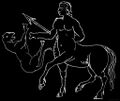Centaurus: Difference between revisions
| Line 15: | Line 15: | ||
File:Centaurus et Lupus - Mercator.jpeg|Centaurus and Lupus constellations from the Mercator celestial globe 1551 (CC0). |
File:Centaurus et Lupus - Mercator.jpeg|Centaurus and Lupus constellations from the Mercator celestial globe 1551 (CC0). |
||
File:Uranometria Centaurus.jpg|Centaurus as drawn by Joh. Bayer (1603) and Lupus drawn by the user of this exemplar of the atlas (extra map for Bayer). |
File:Uranometria Centaurus.jpg|Centaurus as drawn by Joh. Bayer (1603) and Lupus drawn by the user of this exemplar of the atlas (extra map for Bayer). |
||
File:Simon1894 Cen+Lup.jpg|Centaurus et Lupus r at Planisferio celeste (Carlos Simon 1894) |
|||
</gallery> |
</gallery> |
||
Revision as of 19:11, 15 September 2024
One of the 88 IAU constellations. The ancient Greek constellation of the Centaur forms a super-constellation with Lupus and Ara. It is unknown whether or not Centaurus had a Babylonian predecessor: The Mesopotamian uranologies in this area mention a god (Numushda) whose appearance and exact location in the sky are not preserved, and the constellation UR.IDIM which is commonly translated as "Mad Dog" (or rabid dog) but also associated with a benevolent door keeper daemon who is a lion-man. Such a lion-man may possibly be depicted in seal imprints and mythologically named Urmahlullu.
Etymology and History
The Greek constellation is possibly derived from a Babylonian one. There were several centaur-like creatures and other mixed man-animal beings in Mesopotamian culture; seal imprints and reliefs witness them.











